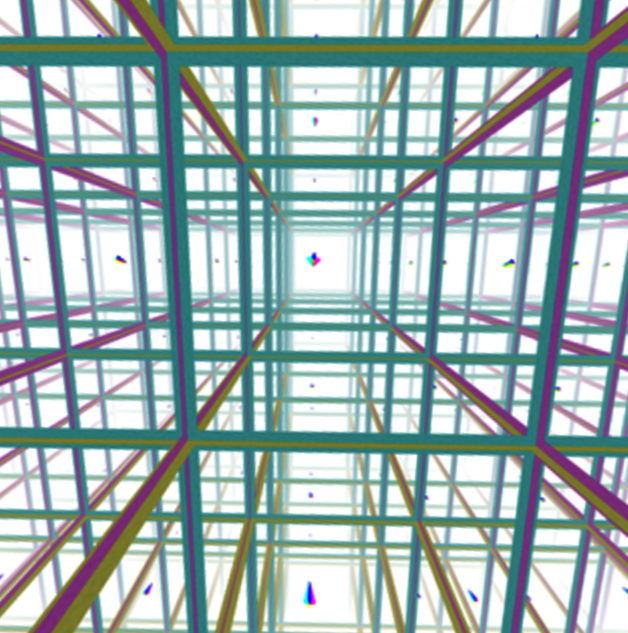The universe’s shape and its oldest light

The 3-torus is a strange and wonderful shape. We can’t readily visualise it because it has a complicated structure, but there’s a way. Imagine you’re standing inside a cube in which light is moving from the left face towards the right face. If the two faces are opaque, the right face will absorb the light, say, and that will be that. But say the two faces are not opaque. Instead, if the light passes through the right face and reemerges from the left face — as if it entered a portal and emerged on the other side — you’ll be standing inside a 3-torus.
If you look in front of you or behind you, you’ll see a series of cubes: they’re all the same cube (the one in which you’re standing) illuminated by the light, which is simply flowing in a closed loop through a single cube. In the early 1980s, physicists proposed that our universe could have the shape of a 3-torus at the largest scale. “There’s a hint in the data that if you traveled far and fast in the direction of the constellation Virgo, you’d return to Earth from the opposite direction,” a 2003 The New York Times article quoted cosmologist Max Tegmark as saying. The idea is funky but it’s possible. Scientists believe our universe’s geometry was determined by quantum processes that happened just after the Big Bang, but they’re not yet sure what that geometry really is. For now, the data are not inconsistent with a 3-torus, according to a paper a team of scientists calling themselves the COMPACT collaboration published in April 2024.
Scientists try to determine the shape of the universe just the way you would have standing inside the 3-torus: using light, and what it’s revealing ahead and behind you. Light passing through a 3-torus would be in a closed loop, which means the visual information it encodes should be repeated: that is, you would’ve seen the same cube repeated ad infinitum, sort of (but not exactly) like when you stand between two mirrors and see endless repetition of the space you’re in on either side. Scientists check for similar patterns that are repeated through the universe. They haven’t found such patterns so far — but there’s a catch. The distance light has travelled matters.
Say the cube you’re standing in is 1 km wide. The light will cross this distance in one-trillionth of a second. If it is 777 billion km wide, the light will take a month. And it will take a full year if the cube is 9.5 trillion km wide. We’re talking about whether the universe could be a 3-torus, and the universe was created 13.8 billion years ago. In this time, light can travel a distance of more than 100 sextillion km. If the width of the cube is less than this distance, we might have seen repeating patterns if the universe is shaped like a 3-torus. But if the cube is even wider, the light wouldn’t have finished crossing it even once since the universe was born, therefore no repeating patterns — yet the possibility of the universe being 3-torus-shaped remains. We just need to wait for the light to finish crossing it once.
Since we can learn so much about the universe’s geometry by studying light, and light that’s travelled the longest would be most useful, scientists are very interested in light ‘left over’ from the Big Bang. Yes, this light is still hanging around, and it’s measurably different from all the other light. Scientists call it the cosmic microwave background (CMB), a.k.a. ‘relic radiation’. It’s left over from a cosmic event that happened just 370,000 years after the Big Bang. We need to subtract the distance light could have travelled in this time from the 100 sextillion km figure (I’m tired of looking at zeroes; you can give it a shot if you like) to find the maximum distance the CMB could have travelled.
In its April paper, the COMPACT collaboration considered data about the universe that astrophysicists have collected using ground and space telescopes over the years — including about the CMB — and with that have checked whether the possibility still exists that our universe could be shaped like three types of a 3-torus. The first type is the one I’ve considered in this post, and they’ve concluded (as expected) that if the cube is less wide than the distance light could’ve travelled since the universe was born, our universe can’t be shaped like this particular 3-torus. The reason is that the data astrophysicists have put together doesn’t contain signs of repeating patterns.
(Update, 8.20 pm, June 23, 2024: Here’s a good primer of what these patterns will actually look like, courtesy Nirmal Raj.)
However, the COMPACT team adds, our universe could still be shaped like one of the other two types of 3-tori even if their respective cubes are smaller than the max. distance. This is because these two shapes include twists that will produce two subtly different images of the universe once the light has completed one loop. And according to the COMPACT folks, they can’t yet eliminate the presence of these images in the astrophysics data. The collaboration’s members have written in the April 2024 paper that they intend to find new/better ways to ascertain their hypotheses with CMB data.
Until then, look out for… déjà vu?



